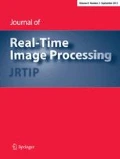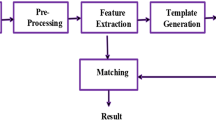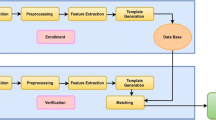Abstract
This paper presents a real-time image acquisition system with an improved image quality assessment module to acquire high-quality near infrared (NIR) images. Thermal imaging plays a vital role in a wide range of medical and military applications. The demand for high-throughput image acquisition and image processing has continuously increased especially for critical medical and military purposes where executions under real-time constraints are required. This work implements an NIR image quality assessment module, which utilizes improved two-dimensional entropy and mask-based edge detection algorithms. The effectiveness of the proposed image quality assessment algorithms is demonstrated through the implementation of a complete finger-vein biometric system. The proposed model is implemented as an embedded system on a field programmable gate array prototyping platform. By including the image quality assessment module, the proposed system is able to achieve a recognition accuracy of 0.87 % equal error rate, and can handle real-time processing at 15 frames/s (live video rate). This is achieved through hardware acceleration of the proposed image quality assessment algorithms via a novel streaming architecture.




















Similar content being viewed by others
Notes
Finger placement in between illumination source and infrared camera for NIR image capture.
In the context of image/video processing, real-time constraints refer to the requirement for the image processing tasks to be completed at live video rate which is typically 30 frames/s [2].
Mathematical complexity for Fourier transform-based Canny edge detection on an \(M \times N\) image is O(MNlogMN).
Mathematical complexity of a general convolution-based image processing operation on an \(M \times N\) image using \(m \times n\) kernel is O(MNmn).
NIR images in a stream of video frames captured under different levels of infrared light intensity.
References
Abutaleb, A.: Automatic thresholding of gray-level pictures using two-dimensional entropy. Comput. Vis. Graph. Image Process. 47, 22–32 (1989)
Athanas, P.M., et al.: Real-time image processing on a custom computing platform. Computer 28(2), 16–25 (1995)
Bailey, D.G.: Design for embedded image processing on FPGAs. Wiley, New Zealand (2011)
Costa, C.M.A., Sillero-Quintana, M., Cano, S.P., Moreira, D., Brito, C., Fernandes, A., Pussieldi, G., Marins, J.: Daily oscillations of skin temperature in military personnel using thermography. J. R. Army Med. Corps, pp. jramc–2015 (2015)
Cui, J.J., Li, Q., Jia, X.: An image quality assessment algorithm for palm-dorsa vein based on multi-feature fusion. Adv. Mater. Res. 508, 96–99 (2012)
Deny, J., Sivasankari, N.: Biometric security in military application. Proc. Eng. 38, 1138–1144 (2012)
Diakides, M., Bronzino, J.D., Peterson, D.R.: Medical Infrared Imaging: Principles and Practices. CRC press (2012)
Eng, P.C.: Finger-vein biometric authentication in a system-on-chip based on field programmable gate arrays. Master’s thesis, Universiti Teknologi Malaysia (2011)
Gold, S.: Military biometrics on the frontline. Biom. Technol. Today 2010(10), 7–9 (2010)
Gray, R.: Entropy and information theory. Springer Verlag (2010)
Hashimoto, J.: Finger vein authentication technology and its future. In: Symposium on VLSI Circuits Digest of Technical Papers, pp. 5–8. IEEE, Honolulu (2006)
Herschel, W.: Experiments on the refrangibility of the invisible rays of the sun. by william herschel, ll. dfrs. Philos. Trans. R. Soc. Lond., pp. 284–292 (1800)
Kalomiros, J.A., Lygouras, J.: Design and evaluation of a hardware/software FPGA-based system for fast image processing. Microprocess. Microsyst. 32(2), 95–106 (2008)
Khalil-Hani, M., Eng, P.C.: FPGA-based embedded system implementation of finger vein biometrics. In: IEEE symposium on industrial electronics applications (ISIEA), pp. 700–705. IEEE, Penang (2010)
Khalil-Hani, M., Eng, P.C.: Personal verification using finger vein biometrics in FPGA-based system-on-chip. In: 7th international conference on electrical and electronics engineering (ELECO), pp. II-171–II-176. IEEE, Bursa(2011)
Khalil-Hani, M., Lee, Y.H.: FPGA embedded hardware system for finger vein biometric recognition. In: 39th annual conference of the IEEE industrial electronics society, IECON 2013, pp. 2273–2278. IEEE, Vienna (2013)
Kilts, S.: Advanced FPGA design: architecture, implementation, and optimization. Wiley (2007)
Lee, E.C., Park, K.R.: Image restoration of skin scattering and optical blurring for finger vein recognition. Opt. Lasers Eng. 49(7), 816–828 (2011)
Lee, Y.H., Khalil-Hani, M., Bakhteri, R.: FPGA-based finger vein biometric system with adaptive illumination for better image acquisition. In: IEEE Symposium on computer applications and industrial electronics (ISCAIE), pp. 107–112. IEEE, Kota Kinabalu (2012)
Li, C., Liang, R., Tian, R., Guan, S., Yan, D., Luo, J., Wei, M., Evans, D.G., Duan, X.: A targeted agent with intercalation structure for cancer near-infrared imaging and photothermal therapy. RSC Adv. 6(20), 16608–16614 (2016)
Li, S.A., Hsu, C.C., Wong, C.C., Yu, C.J.: Hardware/software co-design for particle swarm optimization algorithm. Inf. Sci. 181(20), 4582–4596 (2011)
Lu, J., Wu, X.: A novel multiple modes PWM controller for LEDs. In: International symposium on circuits and systems (ISCAS), pp. 1767–1770. IEEE, Taipei (2009)
Ma, H., Wang, K., Fan, L., Cui, F.: A finger vein image quality assessment method using object and human visual system index. In: Yang, J., Fang, F., Sun, C. (eds.) Intelligent science and intelligent data engineering, pp. 498–506. Springer, Heidelberg (2013)
Martins, R.F.S., do Prado Paim, T., de Abreu Cardoso, C., Dallago, B.S.L., de Melo, C.B., Louvandini, H., McManus, C.: Mastitis detection in sheep by infrared thermography. Res. Vet. Sci. 94(3), 722–724 (2013)
Miller, B.: Vital signs of identity [biometrics]. IEEE Spectr. 31(2), 22–30 (1994)
Miura, N., Nagasaka, A., Miyatake, T.: Feature extraction of finger-vein patterns based on repeated line tracking and its application to personal identification. Mach. Vis. Appl. 15(4), 194–203 (2004)
Narra, P., Zinger, D.: An effective LED dimming approach. In: 39th industry applications conference (IAS), vol. 3, pp. 1671–1676. IEEE (2004)
Pang, S., Yin, Y., Yang, G., Li, Y.: Rotation invariant finger vein recognition. In: Zheng, WS., et al. (eds.) Biometric recognition, pp. 151–156. Springer, Heidelberg (2012)
Park, Y.H., Park, K.R.: Image quality enhancement using the direction and thickness of vein lines for finger-vein recognition. Int. J. Adv. Robotic Syst. 9(154), 1–10 (2012)
Qin, H., Li, S., Kot, A.C., Qin, L.: Quality assessment of finger-vein image. In: Asia-pacific signal & information processing association annual summit and conference (APSIPA ASC), pp. 1–4. IEEE, Hollywood (2012)
Shannon, C.E.: A mathematical theory of communication. ACM SIGMOBILE Mob. Comput. Commun. Rev. 5(1), 3–55 (2001)
Tong, J.G., Anderson, I.D., Khalid, M.A.: Soft-core processors for embedded systems. In: International conference on microelectronics, 2006. ICM’06., pp. 170–173. IEEE (2006)
Vliegen, J., Mentens, N., Verbauwhede, I.: Secure, remote, dynamic reconfiguration of FPGAs. ACM Trans. Reconfigurable Technol. Syst. (TRETS) 7(4), 35 (2015)
Wang, L., Leedham, G.: Near-and far-infrared imaging for vein pattern biometrics. In: International conference on video and signal based surveillance (AVSS), 52. IEEE, Sydney (2006)
Winder, S.: Power supplies for LED driving. Elsevier (2011)
Xin, Y., Liu, Z., Zhang, H., Zhang, H.: Finger vein verification system based on sparse representation. Appl. Opt. 51(25), 6252–6258 (2012)
Xu, J., Jianjiang, C., Dingyu, X., Feng, P.: Near infrared vein image acquisition system based on image quality assessment. In: International conference on electronics, communications and control (ICECC), pp. 922–925. IEEE, Ningbo (2011)
Yang, J., Shi, Y., Yang, J.: Finger-vein image restoration based on a biological optical model, pp. 749–752. IEEE, Beijing (2012)
Zhu, F., Zhang, D., He, Y., Liu, F., Sun, D.W.: Application of visible and near infrared hyperspectral imaging to differentiate between fresh and frozen-thawed fish fillets. Food Bioprocess Technol. 6(10), 2931–2937 (2013)
Acknowledgments
This work is supported by the Ministry of Science, Technology and Innovation of Malaysia (MOSTI) and Universiti Teknologi Malaysia (UTM) under Technofund Grant Vote No. 3H001.
Author information
Authors and Affiliations
Corresponding author
Rights and permissions
About this article
Cite this article
Lee, Y.H., Khalil-Hani, M., Bakhteri, R. et al. A real-time near infrared image acquisition system based on image quality assessment. J Real-Time Image Proc 13, 103–120 (2017). https://doi.org/10.1007/s11554-016-0586-y
Received:
Accepted:
Published:
Issue Date:
DOI: https://doi.org/10.1007/s11554-016-0586-y




